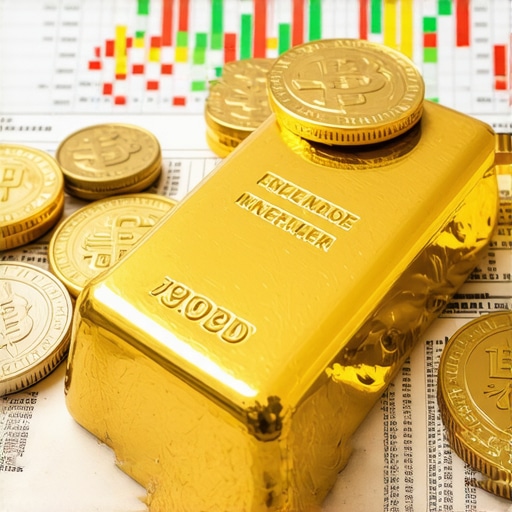Why Should Your Retirement Plan Spark a Gold Rush?
Picture this: You’re at a crossroads with your retirement investments, and the age-old question pops up — should you go for a Gold IRA or stick with the tried-and-true Traditional IRA? It’s like choosing between a classic novel and a shiny new bestseller. Both have their charm, but which one will really keep your financial future bright? Let’s unravel the story behind these two retirement options with a little flair and a lot of insight.
Traditional IRA: The Trusty Old Friend with a Few Surprises
The Traditional IRA is like that reliable old sedan — it’s been around forever and still gets the job done. Contributions may be tax-deductible, meaning you get a nice immediate tax break. Your investments grow tax-deferred, and you only pay taxes when you withdraw during retirement. Sounds straightforward, right? But beware the mandatory Required Minimum Distributions (RMDs) starting at age 73, which can force withdrawals whether you’re ready or not.
Gold IRA: The Glittering Rebel in Retirement Planning
Enter the Gold IRA, the rebellious cousin who doesn’t just follow the rules but shines in a league of its own. Instead of stocks or bonds, your retirement nest egg holds physical gold or other precious metals. This option appeals to those wary of market volatility and inflation — gold has historically been a hedge against economic uncertainty. Plus, with the right custodian, your gold is securely stored, ticking away quietly as the market dances.
Is Gold Really the Golden Ticket to a Safer Retirement?
Here’s the million-dollar question—or should I say, the million-ounce question. While gold has a reputation for stability, it doesn’t generate dividends or interest like stocks or bonds. So, is it truly a better bet or just a shiny distraction? Experts often suggest a balanced approach: a mix of traditional assets and a sprinkle of gold to diversify your portfolio and protect against inflation’s sneaky erosion of purchasing power.
If you’re intrigued by the idea of physical gold, but unsure where to start, this step-by-step guide to starting Gold IRA investments safely is a treasure trove of information.
In the End, It’s About Your Story
Your choice between Gold IRA and Traditional IRA isn’t just about numbers — it’s about your risk appetite, retirement goals, and peace of mind. Remember, even the most seasoned investors consult trusted sources like Investopedia’s IRA guide to navigate these waters wisely. So, what’s your take? Are you team gold glimmer or classic IRA comfort? Drop your thoughts in the comments below — let’s get this financial conversation shining bright!
Deepening the Dive: How Gold IRAs Enhance Portfolio Resilience
While the initial allure of a Gold IRA often centers on its inflation-hedging properties, the real strength lies in its ability to diversify your portfolio against systemic risks that traditional assets can’t always shield you from. Gold’s low correlation with equities and bonds means that during market downturns, it often serves as a buffer, stabilizing the overall portfolio. However, it’s crucial to understand that physical gold requires secure storage and insurance, factors that add layers of complexity and cost compared to a traditional IRA’s digital holdings.
For those looking to master the practicalities, exploring best physical gold investments such as coins versus bars can illuminate which forms of gold align best with your investment goals and risk tolerance.
Traditional IRA: Evolving with Strategic Asset Allocation
Traditional IRAs remain a cornerstone for retirement planning, especially when paired with disciplined asset allocation strategies. Incorporating a range of assets—stocks, bonds, and sometimes real estate investment trusts—can mitigate risks inherent in any single class. Unlike Gold IRAs, Traditional IRAs often offer more liquidity and a broader array of investment vehicles, which may suit investors with longer time horizons or those seeking income generation through dividends and interest.
What Are the Hidden Costs and Benefits of Gold IRAs Versus Traditional IRAs?
This question often puzzles investors weighing these two retirement vehicles. Beyond the obvious differences, consider the fees associated with Gold IRAs, such as custodian fees, storage costs, and the premium over spot gold prices. Traditional IRAs might have lower administrative fees but are exposed to market volatility and inflation risk. A comprehensive evaluation also involves tax implications; while both IRAs offer tax advantages, the timing of tax payments and potential penalties for early withdrawals differ significantly.
According to Kiplinger, a trusted authority in financial guidance, investors should carefully assess their investment horizon, risk tolerance, and inflation outlook before committing to a Gold IRA. This nuanced perspective underscores the importance of personalized financial planning rather than a one-size-fits-all approach.
Expanding Your Gold Investment Toolkit
For those intrigued by precious metals but hesitant to commit entirely to physical gold, diversifying within the gold investment space can be a savvy move. This may include gold ETFs, mutual funds, or mining stocks, each offering varying exposure levels, liquidity, and risk profiles. Learning how to navigate gold trading techniques for beginners can empower investors to make informed decisions and optimize entry points, especially during volatile market conditions.
Moreover, understanding secure storage options is vital. Refer to the ultimate guide to physical gold storage and security tips to safeguard your tangible assets effectively.
Is integrating a Gold IRA into your retirement strategy a wise move in today’s economic climate?
Given the unpredictable global economy, rising inflation rates, and geopolitical tensions, the question resonates with many investors. While no investment is foolproof, the strategic incorporation of gold can lend stability and confidence. However, consulting with a financial advisor who understands both traditional and precious metals markets is essential to tailor a plan fitting your unique retirement goals.
What’s your perspective? Share your experiences or questions about Gold IRAs versus Traditional IRAs in the comments below. Engaging in this dialogue not only sharpens your strategy but also helps others navigate the complexities of retirement planning.
Unlocking the Tax Labyrinth: Strategic Approaches to Gold IRA Withdrawals and RMDs
Diving deeper into Gold IRAs reveals a nuanced landscape, especially when considering tax implications and required minimum distributions (RMDs). Unlike Traditional IRAs, Gold IRAs hold physical assets, making the process of fulfilling RMDs more intricate. Custodians often require liquidation of physical gold to satisfy these distributions, which can trigger capital gains taxes depending on the holding period and market price fluctuations. This complexity demands a comprehensive withdrawal strategy that balances tax efficiency with portfolio integrity.
Moreover, investors should be mindful of the IRS regulations surrounding collectible assets within IRAs. Gold coins and bullion must meet certain purity standards, or risk losing favorable tax treatment. Consulting the IRS official guidelines on IRA distributions and rollovers is essential for avoiding costly missteps.
Advanced Portfolio Engineering: Leveraging Gold’s Low Correlation in Multi-Asset Retirement Strategies
Seasoned investors recognize that the true power of Gold IRAs lies not merely in owning gold, but in integrating it as a dynamic component within a sophisticated asset-allocation model. By leveraging gold’s historically low correlation with equities and fixed income, portfolio managers can significantly dampen volatility and enhance risk-adjusted returns. For example, incorporating a 5-15% allocation to gold-related assets can act as a ballast during equity market drawdowns, providing a smoother glide path toward retirement goals.
However, tactical allocation requires continual recalibration. Macro-economic indicators such as real interest rates, currency strength, and geopolitical risks must inform the timing and scale of gold investments. Employing quantitative models and scenario analysis can illuminate optimal entry and exit points, ensuring that gold’s portfolio role is both strategic and responsive.
How do custodial and storage choices impact the long-term viability of Gold IRAs?
Choosing the right custodian and storage solution is paramount for safeguarding your physical gold and preserving its tax-advantaged status. Custodians vary widely in fees, insurance coverage, and security protocols. For instance, some offer segregated storage—where your specific metals are individually accounted for—while others use commingled pools, which can complicate ownership clarity.
Additionally, geographic location of storage facilities can affect risk exposure to political or regulatory changes. Opting for federally insured depositories with robust security measures not only protects your assets but also ensures compliance with IRS requirements. Delve into this comprehensive guide on physical gold storage and security to make informed decisions that align with your retirement strategy.
Integrating Emerging Precious Metals Trends: Beyond Gold in Retirement Planning
While gold remains the centerpiece of precious metals investing, savvy investors are increasingly exploring diversification into complementary metals such as silver, platinum, and palladium. These metals often exhibit different supply-demand dynamics and industrial applications, potentially offering unique hedging benefits against inflation and market shocks.
For instance, silver’s dual role as both an investment and industrial metal introduces distinct price drivers, while platinum’s price is influenced heavily by automotive catalytic converter demand. Incorporating a measured allocation to these metals within a self-directed IRA can further enhance portfolio diversification and resilience. However, each metal comes with its own liquidity considerations and storage requirements, demanding expert guidance.
Emerging technologies such as blockchain-based precious metals tokens are also gaining traction, promising increased liquidity and easier transferability without sacrificing the underlying physical asset backing. Investors intrigued by these innovations should stay informed through authoritative sources like the Nasdaq overview on precious metals and blockchain integration.
The evolving precious metals landscape presents both exciting opportunities and complex challenges, underscoring the need for continuous education and professional advice.
Ready to elevate your retirement planning with cutting-edge insights? Explore our expert-curated resources and connect with certified financial planners specializing in precious metals IRAs to craft a tailored strategy that withstands the test of time.
Elevating Your Retirement Strategy with Tactical Gold IRA Allocations
Incorporating gold into your retirement portfolio is no longer a mere defensive maneuver—it’s transformed into a sophisticated strategic play. Seasoned investors understand that the optimal Gold IRA allocation isn’t static; it demands agility, adjusting dynamically with shifting economic tides. For example, during periods of rising inflation or geopolitical turbulence, a higher percentage allocation to gold can fortify your portfolio’s resilience. Conversely, in stable economic climates, a more conservative gold position might free capital for growth-oriented traditional assets.
To navigate this complex choreography, leveraging advanced portfolio optimization tools and scenario modeling can illuminate how gold’s inclusion impacts overall risk and return metrics. Such quantitative approaches, complemented by qualitative insights into macroeconomic trends, enable investors to fine-tune their allocations with precision.
What Are the Nuanced Tax Implications of Liquidating Gold IRA Assets Compared to Traditional IRAs?
Liquidating assets within a Gold IRA involves more intricate tax considerations than traditional IRA withdrawals. Since Gold IRAs hold physical bullion or coins, custodians often require selling these tangible assets to meet Required Minimum Distributions (RMDs) or withdrawal requests. This liquidation can trigger capital gains tax events, especially if the gold has appreciated substantially since acquisition. Moreover, the IRS treats certain gold coins as collectibles, subjecting gains to a higher tax rate capped at 28%, unlike the standard income tax rates applied to Traditional IRA distributions.
Understanding these distinctions is critical for tax-efficient retirement planning. Experts recommend consulting authoritative resources like IRS guidelines on IRA distributions and rollovers to ensure compliance and optimize tax outcomes.
Gold Custodians and Storage: The Silent Guardians of Your Retirement Wealth
Choosing a custodian is arguably the most consequential decision for Gold IRA investors. Beyond basic security, custodians dictate storage methods, insurance coverage, and asset segregation policies—each influencing your long-term investment viability. For instance, segregated storage ensures your gold is individually identified and insulated from other clients’ holdings, enhancing ownership clarity and reducing counterparty risk. In contrast, commingled storage pools assets, which might lower fees but complicate asset traceability.
Geographic location of storage facilities further adds layers of risk management. Facilities situated in politically stable jurisdictions with stringent regulatory oversight offer superior protection against geopolitical upheavals or regulatory changes that could jeopardize asset access.
For an in-depth exploration of storage solutions and security best practices, visit our ultimate guide to physical gold storage and security tips.
Integrating Gold Trading Expertise into Your IRA Strategy for Market Volatility
Gold’s reputation as a safe haven doesn’t preclude price fluctuations, especially in volatile markets. Mastering expert gold trading techniques within a Gold IRA context can enhance portfolio performance and mitigate downside risks. This includes understanding when to capitalize on short-term price movements and when to hold steady for long-term resilience.
Investors can benefit from resources detailing proven gold trading techniques tailored for volatile market conditions, which provide tactical insights on timing, risk management, and diversification within precious metals holdings.
These strategies, when applied judiciously, transform gold from a passive hedge into an active portfolio component that contributes to both capital preservation and growth.
How Can Emerging Technologies Revolutionize Gold IRA Management and Liquidity?
The advent of blockchain and tokenization is reshaping the precious metals investment landscape, promising unprecedented transparency and liquidity for Gold IRA assets. Blockchain-enabled platforms allow fractional ownership, instantaneous settlement, and immutable provenance records, reducing traditional friction points associated with physical gold transactions.
While still emerging, these innovations could democratize access and streamline custodian interactions, making Gold IRAs more accessible and flexible. Investors curious about these cutting-edge developments should stay informed through specialized analyses such as the Nasdaq overview on precious metals and blockchain integration.
We invite you to share your thoughts and experiences with Gold IRAs in the comments below. Have you leveraged advanced strategies or technology to optimize your retirement portfolio? Join the conversation and empower fellow investors with your insights.

Expert Insights & Advanced Considerations
Gold’s Strategic Role Beyond Inflation Hedging
While gold’s reputation as a hedge against inflation is well-established, its true strategic value lies in portfolio diversification. Gold’s low correlation with equities and bonds allows it to act as a stabilizer during market turbulence, enhancing risk-adjusted returns when integrated thoughtfully within a retirement portfolio.
Custodial Choices and Storage Methods: Critical to Gold IRA Success
Selecting the right custodian and storage solution is paramount. Segregated storage offers clear ownership and reduced counterparty risk, whereas commingled storage may lower fees but complicate asset traceability. Additionally, storing gold in politically stable jurisdictions with insured facilities ensures both security and compliance with IRS mandates.
Dynamic Allocation: Timing Your Gold IRA Exposure
Optimal Gold IRA allocation is not static. Experienced investors adjust their gold holdings in response to economic indicators such as inflation trends, interest rates, and geopolitical risks. Tactical adjustments—ranging typically from 5% to 15% of a portfolio—can materially improve resilience without sacrificing growth potential.
Navigating Tax Nuances in Gold IRA Liquidations
Liquidating physical gold within an IRA involves complex tax considerations. Unlike traditional IRAs taxed as ordinary income upon withdrawal, gold may be subject to collectible tax rates capped at 28%, impacting long-term tax efficiency. Careful planning and consultation with tax professionals are essential to optimize withdrawal strategies and avoid surprises.
Integrating Emerging Technologies for Enhanced Gold IRA Management
Blockchain and tokenization innovations promise to revolutionize Gold IRA liquidity and transparency. These technologies enable fractional ownership and rapid settlement, potentially reducing custodian friction and expanding investor accessibility—though regulatory clarity and adoption remain evolving.
Curated Expert Resources
- Step-by-step Guide to Starting Gold IRA Investments Safely: An indispensable resource for navigating initial setup, custodian selection, and compliance nuances.
- Ultimate Guide to Physical Gold Storage and Security Tips: Offers comprehensive advice on secure storage options, insurance, and best practices critical for preserving asset integrity.
- Proven Gold Trading Techniques for Volatile Market Conditions: Delivers tactical insights for timing and managing gold exposure amid market fluctuations.
- Best Physical Gold Investments: Coins Versus Bars Explained: Clarifies the pros and cons of different physical gold forms to align investment choices with goals and risk tolerance.
- Gold Trading for Beginners: Key Tools and Strategies to Succeed: A practical primer for investors seeking to enhance their gold trading acumen within IRA frameworks.
Final Expert Perspective
Choosing between a Gold IRA and a Traditional IRA transcends simple preference; it requires a nuanced understanding of market dynamics, tax implications, and personal risk tolerance. Gold IRAs offer a compelling avenue for diversification and inflation protection but demand meticulous attention to custodian selection, storage security, and withdrawal strategies. Advanced investors who incorporate dynamic allocation strategies and stay abreast of emerging technologies can position their portfolios for superior resilience and growth.
For those committed to fortifying their retirement with precious metals, leveraging expert resources and engaging with financial professionals versed in both traditional and gold IRAs is indispensable. How will you integrate these insights into your retirement strategy? Share your advanced approaches or questions below, and continue your journey toward a robust, well-informed retirement portfolio.











The comparison between Gold IRAs and Traditional IRAs really highlights the complexities behind retirement planning choices. I appreciate how the post points out that while Traditional IRAs offer more liquidity and income-generating options, Gold IRAs provide a unique diversification, especially as a hedge against inflation and market volatility. I’ve personally struggled with balancing growth potential against stability — the idea of incorporating a modest percentage of gold to stabilize my portfolio during market downturns sounds appealing.
One challenge I find with Gold IRAs is understanding the full scope of custodial and storage decisions—it’s not just about owning gold but ensuring it’s securely stored while maintaining tax advantages. This adds a layer of complexity that isn’t present with traditional digital assets. Also, the tax implications when liquidating physical gold, especially with collectible status and higher tax rates, are aspects that many might overlook.
I’m curious, for those who have experience with Gold IRAs, how do you approach the ongoing management of the gold allocation? Do you adjust your holdings based on economic indicators like inflation and geopolitical risks, or do you tend to keep a steady percentage? I’d love to hear practical insights on balancing agility with long-term strategies in managing gold’s role in a retirement portfolio.